Quick Summary:
- Your website is your 24/7 digital office for clients.
- Clearly list services, offer a secure client portal.
- Ensure mobile-friendly design, great content, and SEO.
- Build trust with testimonials, clear contacts, and security.
Table of Contents
- The Indispensable Digital Foundation: Why Your Accounting Firm Needs a Stellar Website
- The Cost of Neglecting Your Online Presence: Losing Business in the Digital Age
- Feature #1: Crystal-Clear Service Breakdown: Showcasing Your Expertise
- Detailed Service Pages: Diving Deep into Your Offerings
- Targeting Specific Industries: Niche Down to Stand Out
- Service Packages: Simplifying the Selection Process
- Feature #2: The Client Portal: A Secure and Efficient Communication Hub
- Secure Document Sharing: Protecting Sensitive Information
- Communication Made Easy: Streamlining Interactions
- 24/7 Accessibility: Empowering Clients with Self-Service
- Integration with Accounting Software: Seamless Data Flow
- Feature #3: Mobile Responsiveness: Reaching Clients on Any Device
- Prioritizing the Mobile Experience: Optimizing for Smaller Screens
- Testing Across Devices: Ensuring a Consistent Experience
- Mobile-First Indexing: Appeasing the Search Engines
- Feature #4: Compelling Content: Establishing Authority and Trust
- Blog Posts: Sharing Insights and Expertise
- Case Studies: Showcasing Your Success Stories
- Infographics: Visualizing Complex Information
- Videos: Engaging Your Audience
- Keywords to Incorporate:
- Feature #5: Search Engine Optimization (SEO): Getting Found Online
- Keyword Research: Understanding Your Audience’s Search Terms
- On-Page Optimization: Optimizing Your Website’s Content and Structure
- Off-Page Optimization: Building Your Website’s Authority
- Local SEO: Targeting Local Clients
- SEO Tools to Consider:
- Feature #6: Clear Calls to Action (CTAs): Guiding Visitors Towards Conversion
- Strategic Placement: Maximizing Visibility
- Compelling Wording: Persuading Visitors to Act
- Visually Appealing Design: Making CTAs Stand Out
- Examples of Effective CTAs:
- Feature #7: Testimonials and Social Proof: Building Trust and Credibility
- Authenticity is Key: Gathering Genuine Feedback
- Displaying Testimonials Strategically: Maximizing Impact
- Video Testimonials: Adding a Personal Touch
- Other Forms of Social Proof:
- Feature #8: About Us Page: Humanizing Your Firm
- Tell Your Story: Connecting with Your Audience
- Introduce Your Team: Putting Faces to Names
- Highlight Your Expertise: Demonstrating Your Credentials
- Showcase Your Values: Building Trust and Credibility
- Feature #9: Contact Information and Forms: Making it Easy to Connect
- Prominent Placement: Ensuring Visibility
- Contact Forms: Streamlining Inquiries
- Map Integration: Helping Clients Find You
- Live Chat: Providing Instant Support
- Feature #10: Website Security: Protecting Your Clients’ Data
- SSL Certificate: Encrypting Data Transmission
- Strong Passwords and Authentication: Protecting Access
- Regular Security Audits: Identifying Vulnerabilities
- Data Backup and Recovery: Protecting Against Data Loss
- Elevate Your Accounting Firm with Qrolic Technologies
- Our Services for Accounting Firms:
- Why Choose Qrolic Technologies?
- Conclusion: Investing in Your Digital Future
The Indispensable Digital Foundation: Why Your Accounting Firm Needs a Stellar Website
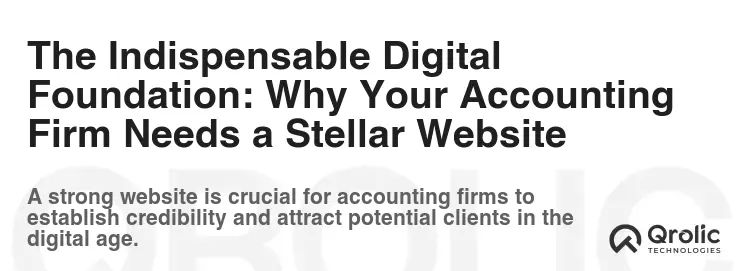
In today’s fiercely competitive landscape, an accounting firm’s website is far more than just a digital brochure. It’s the 24/7 storefront, the initial handshake, and often, the decisive factor for prospective clients. A well-designed, user-friendly, and feature-rich website establishes credibility, attracts leads, and streamlines client communication. This is your opportunity to demonstrate expertise and build trust before you ever meet face-to-face. Think of your website as the hardest-working member of your team, constantly attracting and nurturing leads.
The Cost of Neglecting Your Online Presence: Losing Business in the Digital Age
Failing to invest in a high-quality website is akin to hanging a “Closed” sign on your practice. Potential clients are actively searching online for accounting services. An outdated, clunky, or difficult-to-navigate website screams “unprofessional” and sends them straight to your competitors. You’re missing out on valuable leads, diminishing your brand reputation, and ultimately impacting your bottom line. Don’t let your online presence be the reason you’re losing business.
Feature #1: Crystal-Clear Service Breakdown: Showcasing Your Expertise
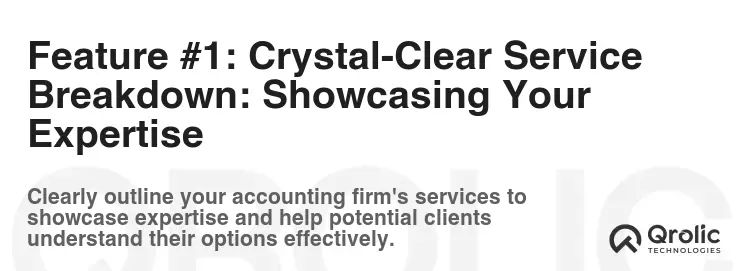
Your website must immediately and comprehensively articulate the services you offer. Don’t assume visitors know what you do; spell it out with detail and clarity. This avoids confusion and ensures potential clients quickly understand how you can help them. A well-defined service breakdown is the cornerstone of an effective accounting firm website.
Detailed Service Pages: Diving Deep into Your Offerings
Each service you offer deserves its own dedicated page. These pages should provide in-depth explanations, addressing common client questions and highlighting the benefits of choosing your firm.
- Tax Preparation: Explain the complexities you handle, the different types of tax returns you prepare (individual, corporate, partnership), and how you minimize tax liabilities. Use examples like, “We specialize in maximizing deductions for small business owners, helping them keep more of what they earn.”
- Bookkeeping Services: Outline the scope of your bookkeeping services, from basic transaction recording to comprehensive financial statement preparation. Emphasize the time-saving and accuracy benefits for clients. For example, “Outsource your bookkeeping and free up valuable time to focus on growing your business.”
- Auditing Services: Detail your audit approach, emphasizing your commitment to accuracy, independence, and compliance. Explain the different types of audits you perform and the value they provide to clients.
- Financial Planning: Explain your financial planning process, including retirement planning, investment management, and estate planning. Highlight your expertise in helping clients achieve their long-term financial goals. Offer a free consultation to get started.
- Payroll Services: Describe your payroll processing capabilities, including tax withholding, direct deposit, and reporting. Showcase the convenience and accuracy of your payroll services.
- Business Consulting: Outline your consulting services, such as business valuations, financial forecasting, and strategic planning. Demonstrate your expertise in helping businesses improve their performance and achieve their goals. Use case studies to demonstrate success.
Targeting Specific Industries: Niche Down to Stand Out
If your firm specializes in serving specific industries (e.g., healthcare, real estate, technology), highlight this expertise prominently. Tailor your service descriptions and case studies to resonate with the unique needs of those industries. This shows potential clients that you understand their challenges and are equipped to provide relevant solutions. For instance, “We specialize in helping healthcare practices navigate the complex regulations and financial challenges of the industry.”
Service Packages: Simplifying the Selection Process
Consider offering pre-defined service packages that bundle related services together. This simplifies the selection process for clients and can increase your average engagement value. For example, you could offer a “Small Business Starter Package” that includes bookkeeping, tax preparation, and payroll services.
Feature #2: The Client Portal: A Secure and Efficient Communication Hub
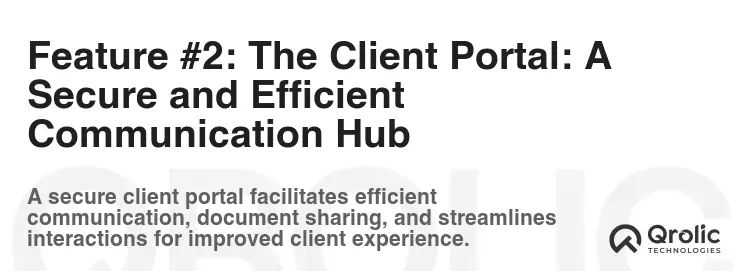
A secure and user-friendly client portal is no longer a luxury; it’s a necessity. It streamlines communication, facilitates document sharing, and enhances client satisfaction. It’s your digital bridge connecting you and your clients.
Secure Document Sharing: Protecting Sensitive Information
The client portal provides a secure and encrypted platform for clients to upload and download sensitive documents, such as tax returns, financial statements, and bank statements. This eliminates the risks associated with email attachments and ensures compliance with data privacy regulations.
- Encryption: Ensure all data transmitted through the portal is encrypted using industry-standard protocols.
- Access Controls: Implement robust access controls to restrict access to sensitive documents based on user roles and permissions.
- Audit Trails: Maintain detailed audit trails of all document access and modifications to ensure accountability and transparency.
Communication Made Easy: Streamlining Interactions
The client portal serves as a central hub for all client communications, including messages, appointment reminders, and task requests. This eliminates the need for endless email chains and ensures that all communication is tracked and documented.
- Messaging System: Integrate a secure messaging system that allows clients and staff to communicate directly within the portal.
- Appointment Scheduling: Allow clients to schedule appointments online through the portal, reducing scheduling conflicts and improving convenience.
- Task Management: Use the portal to assign tasks to clients and track their progress, ensuring that all deadlines are met.
24/7 Accessibility: Empowering Clients with Self-Service
The client portal provides clients with 24/7 access to their financial information, documents, and communication history. This empowers them to manage their finances at their convenience and reduces the burden on your staff.
- Document Library: Provide clients with access to a comprehensive library of their documents, including tax returns, financial statements, and correspondence.
- Account Overview: Offer a consolidated view of their account information, including balances, transactions, and invoices.
- FAQ Section: Include a frequently asked questions (FAQ) section to address common client questions and reduce the need for support inquiries.
Integration with Accounting Software: Seamless Data Flow
Ideally, your client portal should integrate seamlessly with your accounting software, such as QuickBooks or Xero. This allows for automated data synchronization and eliminates the need for manual data entry.
- Real-time Data Updates: Ensure that data is updated in real-time across the portal and your accounting software.
- Automated Reporting: Generate automated reports based on data from your accounting software and make them available to clients through the portal.
- Simplified Tax Preparation: Streamline the tax preparation process by allowing clients to upload their financial data directly to the portal.
Feature #3: Mobile Responsiveness: Reaching Clients on Any Device
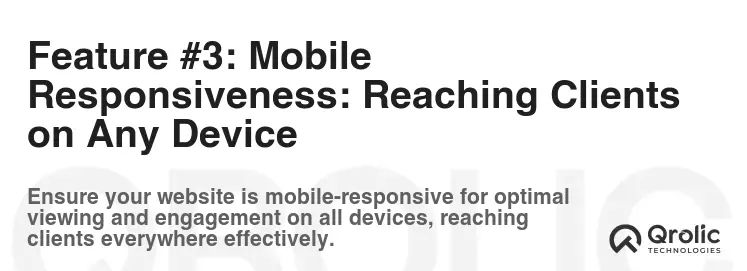
In a mobile-first world, your website must be fully responsive, adapting seamlessly to any screen size, from smartphones to tablets to desktops. A clunky or non-responsive website frustrates users and significantly impacts your search engine rankings. Think of it as making your office easily accessible regardless of how clients choose to visit.
Prioritizing the Mobile Experience: Optimizing for Smaller Screens
Mobile users often have different needs and expectations than desktop users. Prioritize the mobile experience by optimizing your website’s design, content, and navigation for smaller screens.
- Simplified Navigation: Use a clear and concise menu structure that is easy to navigate on a mobile device.
- Large, Tap-Friendly Buttons: Ensure that buttons and links are large enough to be easily tapped on a touchscreen.
- Optimized Images: Optimize images for mobile devices to reduce loading times and conserve bandwidth.
Testing Across Devices: Ensuring a Consistent Experience
Regularly test your website across a variety of devices and browsers to ensure a consistent and optimal user experience. Use online testing tools or manually test on different devices.
- Browser Compatibility: Ensure that your website is compatible with all major web browsers, including Chrome, Firefox, Safari, and Edge.
- Device Emulators: Use device emulators to simulate the experience of using your website on different devices.
- User Feedback: Solicit feedback from clients and staff who use your website on mobile devices to identify areas for improvement.
Mobile-First Indexing: Appeasing the Search Engines
Google uses mobile-first indexing, meaning it primarily uses the mobile version of your website to rank it in search results. Ensure that your mobile website is fully optimized for search engines.
- Mobile-Friendly Design: Use a responsive design that adapts seamlessly to different screen sizes.
- Fast Loading Times: Optimize your website for speed to improve the user experience and search engine rankings.
- Structured Data Markup: Use structured data markup to help search engines understand the content of your website.
Feature #4: Compelling Content: Establishing Authority and Trust
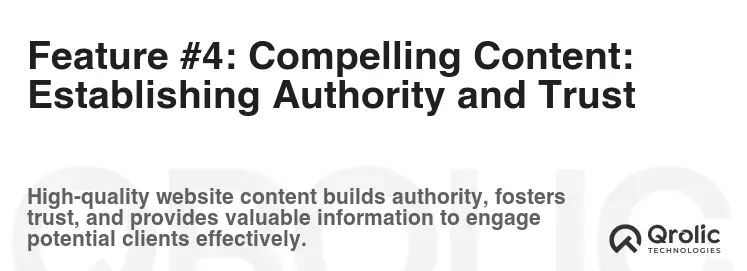
High-quality, informative, and engaging content is crucial for attracting visitors, establishing your firm as a thought leader, and converting leads into clients. Content is King, and in the accounting world, it’s the key to building trust and authority.
Blog Posts: Sharing Insights and Expertise
Regularly publishing blog posts on relevant accounting topics demonstrates your expertise, attracts organic traffic from search engines, and keeps your website fresh and engaging.
- Tax Law Updates: Provide timely updates on changes to tax laws and regulations.
- Financial Planning Tips: Offer practical advice on financial planning topics, such as retirement planning and investment management.
- Business Advice: Share insights on how businesses can improve their financial performance.
- Industry-Specific Content: Create content tailored to the specific needs of your target industries.
Case Studies: Showcasing Your Success Stories
Case studies demonstrate the value of your services by showcasing real-world examples of how you’ve helped clients achieve their goals.
- Quantifiable Results: Emphasize the quantifiable results you’ve achieved for your clients, such as increased profits or reduced tax liabilities.
- Client Testimonials: Include client testimonials to add credibility and build trust.
- Problem-Solution-Result Format: Structure your case studies using the problem-solution-result format to clearly demonstrate the value you provide.
Infographics: Visualizing Complex Information
Infographics are a visually appealing way to present complex information in an easy-to-understand format. They can be used to explain accounting concepts, illustrate financial trends, or showcase your firm’s services.
- Data Visualization: Use charts and graphs to visualize data and make it more accessible.
- Concise Text: Keep the text concise and easy to read.
- Visually Appealing Design: Use a visually appealing design that is consistent with your brand.
Videos: Engaging Your Audience
Videos are a highly engaging way to connect with your audience and showcase your firm’s personality and expertise.
- Welcome Video: Create a welcome video that introduces your firm and its services.
- Educational Videos: Produce educational videos that explain accounting concepts or provide financial advice.
- Client Testimonial Videos: Feature client testimonial videos to build trust and credibility.
Keywords to Incorporate:
- Tax planning strategies
- Small business accounting tips
- QuickBooks tutorials
- Financial statement analysis
- Tax deduction optimization
Feature #5: Search Engine Optimization (SEO): Getting Found Online
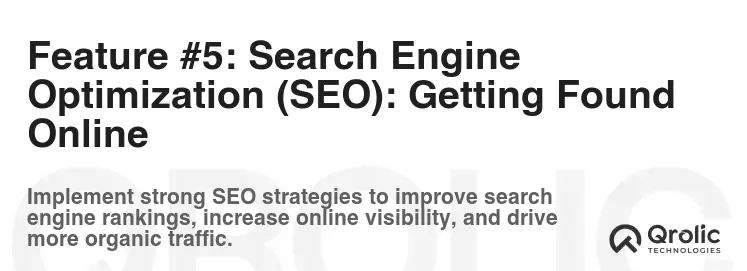
Even the most beautiful and functional website is useless if no one can find it. Search Engine Optimization (SEO) is the process of optimizing your website to rank higher in search engine results, driving more organic traffic and leads.
Keyword Research: Understanding Your Audience’s Search Terms
Start by conducting thorough keyword research to identify the terms that your target audience is using to search for accounting services. Use tools like Google Keyword Planner, SEMrush, or Ahrefs.
- Identify Relevant Keywords: Create a list of relevant keywords that describe your services, target industries, and geographic location.
- Analyze Keyword Search Volume: Analyze the search volume of each keyword to identify the most popular and relevant terms.
- Assess Keyword Competition: Assess the competition for each keyword to identify opportunities to rank higher.
On-Page Optimization: Optimizing Your Website’s Content and Structure
On-page optimization involves optimizing your website’s content and structure to make it more search engine friendly.
- Title Tags and Meta Descriptions: Optimize your title tags and meta descriptions to accurately describe the content of each page and attract clicks from search engine results pages.
- Header Tags: Use header tags (H1, H2, H3, etc.) to structure your content and highlight important keywords.
- Image Alt Text: Add alt text to all images to describe the image content and improve accessibility.
- Internal Linking: Link to other relevant pages on your website to improve navigation and distribute link juice.
Off-Page Optimization: Building Your Website’s Authority
Off-page optimization involves building your website’s authority and reputation through external links and other factors.
- Link Building: Acquire high-quality backlinks from other reputable websites in your industry.
- Social Media Marketing: Promote your website and content on social media to increase brand awareness and drive traffic.
- Online Directories: List your business in online directories, such as Yelp and Google My Business.
Local SEO: Targeting Local Clients
If you serve clients in a specific geographic area, focus on local SEO to improve your visibility in local search results.
- Google My Business: Claim and optimize your Google My Business listing.
- Local Citations: Build local citations by listing your business in online directories and business listings.
- Local Keywords: Incorporate local keywords into your website content and meta descriptions.
SEO Tools to Consider:
- Google Analytics
- Google Search Console
- SEMrush
- Ahrefs
- Moz
Feature #6: Clear Calls to Action (CTAs): Guiding Visitors Towards Conversion

Every page of your website should have clear and compelling Calls to Action (CTAs) that guide visitors towards taking the next step, whether it’s scheduling a consultation, downloading a resource, or contacting your firm. A CTA is the digital equivalent of asking for the business.
Strategic Placement: Maximizing Visibility
Place CTAs strategically throughout your website, ensuring they are visible and relevant to the content on each page.
- Above the Fold: Place CTAs above the fold, so they are immediately visible to visitors.
- Within Content: Integrate CTAs within your content, where they are most relevant to the information being presented.
- End of Content: Place CTAs at the end of your content, encouraging visitors to take the next step after they have finished reading.
Compelling Wording: Persuading Visitors to Act
Use compelling wording that encourages visitors to take action. Focus on the benefits of taking the next step and create a sense of urgency.
- Action Verbs: Use action verbs, such as “Schedule,” “Download,” “Contact,” or “Get Started.”
- Benefit-Oriented Language: Highlight the benefits of taking the next step, such as “Get a Free Consultation” or “Download Our Free Tax Guide.”
- Sense of Urgency: Create a sense of urgency by using phrases like “Limited Time Offer” or “Schedule Your Consultation Today.”
Visually Appealing Design: Making CTAs Stand Out
Make your CTAs visually appealing and easy to identify. Use contrasting colors, large fonts, and clear button designs.
- Contrasting Colors: Use colors that contrast with the surrounding content to make your CTAs stand out.
- Large Fonts: Use large fonts that are easy to read.
- Button Design: Use a clear button design that makes it obvious that the CTA is clickable.
Examples of Effective CTAs:
- “Schedule a Free Consultation”
- “Download Our Free Tax Planning Guide”
- “Contact Us Today for a Personalized Quote”
- “Get Started with Our Bookkeeping Services”
- “Learn More About Our Financial Planning Services”
Feature #7: Testimonials and Social Proof: Building Trust and Credibility

Testimonials and social proof are powerful tools for building trust and credibility with potential clients. They provide evidence that your firm delivers on its promises and provides excellent service. Seeing is believing, and testimonials offer that visual and emotional confirmation.
Authenticity is Key: Gathering Genuine Feedback
Focus on gathering authentic testimonials from satisfied clients. Avoid using generic or overly promotional testimonials.
- Request Specific Feedback: Ask clients to provide specific feedback on the services you provided and the results they achieved.
- Use Real Names and Photos: Use real names and photos of clients to increase credibility.
- Avoid Overly Promotional Language: Avoid using overly promotional language that sounds like marketing copy.
Displaying Testimonials Strategically: Maximizing Impact
Display testimonials strategically throughout your website, particularly on your homepage, service pages, and about us page.
- Homepage: Feature a selection of your best testimonials on your homepage to make a strong first impression.
- Service Pages: Include testimonials that are relevant to the specific services being offered on each page.
- About Us Page: Use testimonials to highlight your firm’s values and commitment to client satisfaction.
Video Testimonials: Adding a Personal Touch
Video testimonials are even more powerful than written testimonials, as they allow potential clients to see and hear from satisfied clients.
- Professional Production: Invest in professional video production to ensure high-quality audio and video.
- Natural and Authentic: Encourage clients to be natural and authentic in their testimonials.
- Focus on Benefits: Ask clients to focus on the benefits they have received from working with your firm.
Other Forms of Social Proof:
- Client Logos: Display the logos of your notable clients to showcase your expertise.
- Awards and Accreditations: Highlight any awards or accreditations your firm has received.
- Case Studies: Share case studies that demonstrate the value of your services.
Feature #8: About Us Page: Humanizing Your Firm

The About Us page is your opportunity to tell your story, introduce your team, and humanize your firm. It’s where you build a connection with potential clients beyond just services.
Tell Your Story: Connecting with Your Audience
Share the story of your firm, including its founding, mission, and values. This helps potential clients connect with your firm on a personal level.
- Founding Story: Share the story of how your firm was founded and the reasons why you started your business.
- Mission Statement: Clearly state your firm’s mission statement and the values that guide your work.
- Company Culture: Describe your company culture and the values that are important to your team.
Introduce Your Team: Putting Faces to Names
Introduce your team members with photos, bios, and contact information. This helps potential clients put faces to names and build trust.
- Professional Photos: Use professional photos of your team members.
- Detailed Bios: Provide detailed bios that highlight each team member’s experience, expertise, and qualifications.
- Contact Information: Include contact information for each team member, such as email addresses and phone numbers.
Highlight Your Expertise: Demonstrating Your Credentials
Highlight your firm’s expertise and credentials, including certifications, licenses, and professional affiliations.
- Certifications and Licenses: List all relevant certifications and licenses held by your team members.
- Professional Affiliations: Mention any professional affiliations your firm has, such as membership in industry associations.
- Years of Experience: Highlight the collective years of experience of your team members.
Showcase Your Values: Building Trust and Credibility
Showcase your firm’s values, such as integrity, professionalism, and client focus. This helps potential clients understand what you stand for and build trust in your firm.
- Commitment to Ethics: Emphasize your commitment to ethical practices and client confidentiality.
- Dedication to Client Service: Highlight your dedication to providing excellent client service and exceeding expectations.
- Focus on Innovation: Showcase your focus on innovation and staying up-to-date with the latest accounting technologies.
Feature #9: Contact Information and Forms: Making it Easy to Connect
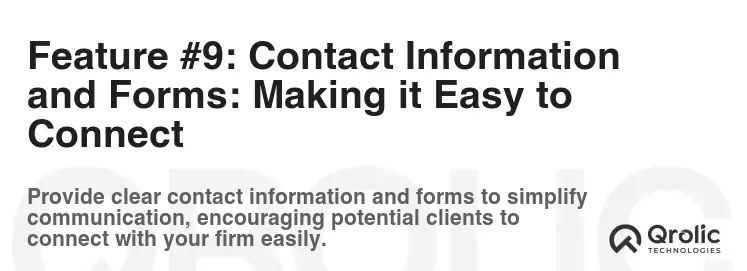
Make it easy for potential clients to contact you by providing clear and accessible contact information and forms throughout your website. Don’t make them hunt for it; make it obvious.
Prominent Placement: Ensuring Visibility
Place your contact information prominently on every page of your website, typically in the header and footer.
- Phone Number: Include your phone number in a prominent location, such as the header of your website.
- Email Address: Provide a contact form so users can fill it out with their information to send you an email.
- Physical Address: If you have a physical office, include your address in the footer of your website.
Contact Forms: Streamlining Inquiries
Use contact forms to streamline inquiries and gather essential information from potential clients.
- Required Fields: Include required fields for essential information, such as name, email address, and phone number.
- Dropdown Menus: Use dropdown menus to allow users to select the type of inquiry they are making.
- Message Box: Provide a message box where users can describe their needs in detail.
Map Integration: Helping Clients Find You
If you have a physical office, integrate a map into your contact page to help clients find your location. Use Google Maps or another mapping service.
- Embed a Map: Embed a map of your location directly into your contact page.
- Provide Directions: Provide directions to your office from major landmarks.
- Include Parking Information: Include information about parking availability near your office.
Live Chat: Providing Instant Support
Consider adding live chat functionality to your website to provide instant support to potential clients.
- 24/7 Availability: Offer live chat support 24/7, or at least during business hours.
- Trained Staff: Train your staff to provide accurate and helpful responses to inquiries.
- Proactive Chat: Use proactive chat to engage with visitors who are browsing your website.
Feature #10: Website Security: Protecting Your Clients’ Data

Website security is paramount, especially for accounting firms that handle sensitive client data. Investing in robust security measures protects your clients, your reputation, and your business.
SSL Certificate: Encrypting Data Transmission
Install an SSL certificate to encrypt data transmitted between your website and visitors’ browsers. This protects sensitive information, such as login credentials and financial data.
- HTTPS Protocol: Ensure that your website uses the HTTPS protocol, which indicates that data is encrypted.
- Valid SSL Certificate: Obtain a valid SSL certificate from a trusted certificate authority.
- Regular Renewal: Renew your SSL certificate regularly to maintain its validity.
Strong Passwords and Authentication: Protecting Access
Use strong passwords and multi-factor authentication to protect access to your website’s backend and client portals.
- Password Complexity Requirements: Enforce password complexity requirements, such as requiring a minimum length and a combination of upper and lowercase letters, numbers, and symbols.
- Multi-Factor Authentication: Implement multi-factor authentication to require users to provide multiple forms of identification, such as a password and a code sent to their mobile device.
- Regular Password Changes: Encourage users to change their passwords regularly.
Regular Security Audits: Identifying Vulnerabilities
Conduct regular security audits to identify and address potential vulnerabilities in your website’s code and infrastructure.
- Vulnerability Scanning: Use vulnerability scanning tools to identify known vulnerabilities in your website’s software and plugins.
- Penetration Testing: Hire a security expert to conduct penetration testing to simulate real-world attacks and identify weaknesses in your security defenses.
- Security Patches: Apply security patches and updates to your website’s software and plugins promptly.
Data Backup and Recovery: Protecting Against Data Loss
Implement a data backup and recovery plan to protect against data loss due to hardware failure, cyberattacks, or human error.
- Regular Backups: Back up your website’s data regularly, preferably daily or weekly.
- Offsite Storage: Store backups offsite to protect against physical damage to your primary servers.
- Recovery Procedures: Develop and test recovery procedures to ensure that you can quickly restore your website in the event of a data loss incident.
Elevate Your Accounting Firm with Qrolic Technologies

At Qrolic Technologies (https://qrolic.com/), we understand the unique needs of accounting firms in the digital age. We specialize in crafting high-performance websites that not only look great but also drive leads, enhance client communication, and boost your online presence. We can handle all technicalities of website, so you can focus on your clients.
Our Services for Accounting Firms:
- Custom Website Design & Development: We create bespoke websites that reflect your brand identity and cater to your specific business requirements.
- SEO Optimization: Our SEO experts will optimize your website to rank higher in search engine results, attracting more organic traffic and potential clients.
- Client Portal Integration: We seamlessly integrate client portals into your website, providing a secure and efficient platform for communication and document sharing.
- Content Creation: Our experienced content writers can create engaging and informative content that establishes your firm as a thought leader.
- Ongoing Support & Maintenance: We provide ongoing support and maintenance to ensure your website remains secure, up-to-date, and performing optimally.
Why Choose Qrolic Technologies?
- Industry Expertise: We have a deep understanding of the accounting industry and the challenges you face.
- Results-Driven Approach: We focus on delivering measurable results, such as increased leads, improved client satisfaction, and enhanced brand reputation.
- Dedicated Support: We provide personalized support and are always available to answer your questions and address your concerns.
- Competitive Pricing: We offer competitive pricing without compromising on quality or service.
Contact Qrolic Technologies today to learn how we can help you transform your online presence and achieve your business goals.
Conclusion: Investing in Your Digital Future

A well-designed and feature-rich website is an indispensable asset for any accounting firm seeking to thrive in today’s competitive landscape. By implementing the features outlined in this article, you can create a website that attracts leads, builds trust, enhances client communication, and ultimately drives business growth. It’s an investment in your firm’s digital future and a key differentiator in a crowded marketplace. Don’t just have a website; have a strategic website that works tirelessly for you.






